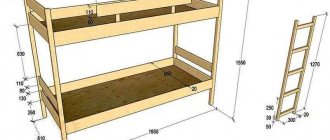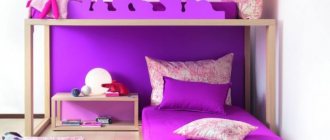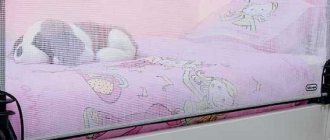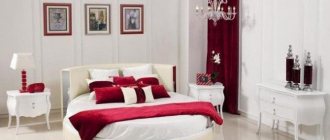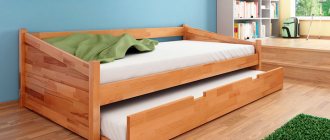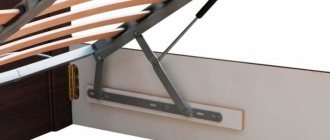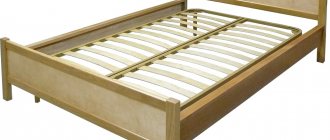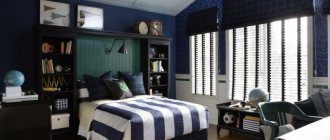How to choose the right material?
When choosing a bed, you should look not only at functionality, but also at the material of the furniture. Its durability and reliability directly depend on this.
For production, laminated chipboard, chipboard, MDF, wood, plastic, metal can be used.
What are the pros and cons of each material?
- The wood is beautiful and durable, it is easy to process, applying ornaments, carving figures, etc. The material is susceptible to wood bugs, and the color range is limited.
Wood does not emit harmful substances, which is very important for children's rooms.
- The cost of a children's bed made from laminated chipboard and MDF is lower compared to wood. But you should avoid them if the owner of the room is allergic, since glue is used in the production of laminated boards and panels from the fraction.
The materials are durable and easy to clean.
- Iron is the most reliable material. It does not warp, does not dry out, and is not sensitive to mechanical damage. It does not require special care.
But the surface is unpleasant to the touch; an iron children's bed is difficult to fit into the design of the room.
- Plastic is resistant to sunlight.
This is an inexpensive option that withstands regular wet cleaning and mechanical damage.
Varieties
Modern roll-out beds are designed not only for small children, but also for teenagers and adults. Models are classified by size, materials of manufacture, location of the lower tier. Many products are equipped with additional elements that increase the practicality and ease of use of the furniture.
Advantages and disadvantages of an orthopedic bed, its dimensions
To size
One of the most important criteria for choosing roll-out beds is dimensions. The following traditional options are possible:
- Single. The width of the bed varies between 80–100 cm, length - 160–200 cm. Models are optimal for children and teenagers.
- One and a half. The width can be from 100 to 140 cm, the length - from 190 to 200 cm. Designs with such parameters are quite rare.
- Double. The standard width is 160–180 cm, length – 190–220 cm.
The most popular is a two-level bed with dimensions of 160 × 80 cm. The dimensions of the lower tier are 8–10 cm smaller than the upper tier, which is why younger children usually sleep downstairs. Models with interesting thematic designs are designed for preschoolers. It is important to remember that such a sleeping place will last only a few years, then you will have to replace it with larger furniture.
The height of the bed is of no small importance. Low models are not equipped with additional drawers. Higher units have built-in storage compartments, so the distance between the lower level and the floor will be greater. There is a simple way to find out the ideal furniture parameters. The optimal bed would be one in which the roll-out element is at the level of the knees of the user, an adult or a child. Otherwise, the process of getting out of bed will be difficult and uncomfortable. Not all bed options are suitable for small spaces. It is recommended to leave at least 90 cm between the upper level and the ceiling.
If you cannot position the traditional model correctly, you should pay attention to a roll-out bunk bed-matryoshka.
Single
One and a half
Double
No additional storage space
With drawers
According to the material of manufacture
Furniture intended for children must be durable, environmentally friendly, and safe. The following types of materials meet the listed requirements:
- Tree. To create the frame, various types of wood are used: birch, oak, pine, ash. All structural elements are carefully ground and polished, coated with varnishes and paints to prevent injuries. Furniture does not tolerate high humidity or temperature changes and requires proper care. The advantages of the material include natural origin, durability, environmental safety, and attractive appearance.
- MDF. Wood fiber boards are often used to create furniture facades. The surface is treated using film, veneer or plastic. A bunk bed made from this material is reliable, durable, and affordable.
- Chipboard. High-quality slabs do not lose their performance properties over a long period of time. The panels are not susceptible to mold, rot, and are protected from mechanical damage.
- Metal and plastic. The first is in most cases used for the production of frames. The second is used together with other materials; it is used for finishing the facade. Plastic is resistant to negative influences and allows you to imitate various textures.
Modern bunk beds made of solid wood in the interior of a nursery
A pull-out bed designed for two children is subject to high loads. Models made from combined materials last a long time. Wooden structures with facades made of MDF, chipboard, and a tandem of metal and wood are popular.
Sometimes beds are made of wood, metal and plastic; usually such products have an original design.
Tree
MDF
Chipboard
Metal
According to the location of the lower tier
The design of pull-out beds provides different options for the location of the lower level. Most often, parallel or perpendicular placement is found in relation to the upper tier. The first option is considered classic; the pull-out beds roll out easily, are not located too high, and are therefore suitable for small children.
The perpendicular arrangement allows you to free up space under the upper bed. This space can be used for additional storage systems: cabinets, shelves. If necessary, organize a full-fledged work area with a small desk.
Parallel
Perpendicular
According to the presence of additional elements
A bed with a pull-out mechanism is often equipped with storage niches. Thanks to the presence of drawers, it is possible to save space in the room. The most convenient option is the location of the compartments under the lower berth. You can place bed linen and seasonal items there.
Types of metal bunk bed designs, scope of application
The ladder helps you climb to the second tier, reducing the risk of injury. Often steps are equipped with shelves and drawers for toys and books. Products intended for children under 6 years of age are equipped with sides, which reduces the risk of the baby falling while sleeping.
With roll-out drawers
With stairs
With ladder and drawers
What to look for when choosing a model?
- Strength.
It is important that the chosen furniture model has stable legs.
- Safety.
The body of the model must be equipped with high sides so that the baby does not fall and get injured.
- The distance between two “floors” and the height of the structure.
If the distance is small, then the neck of the person sitting on the lower tier will begin to hurt.
The upper tier of the model, located too close to the ceiling, makes it difficult for the child to breathe, and it will be difficult for parents to make the bed.
- The staircase should be comfortable and safe.
The best option: a ladder in the form of drawers.
It is convenient to place children's things and toys in them. The steps of this version of a bunk bed should be covered with wood or rubber. Metal or plastic slip, and the child may fall if moved carelessly. This model of furniture should not have sharp corners, protruding bolts or similar traumatic parts.
Pros and cons of the design
Unlike two separate beds, a bunk bed solves the main problem in a small apartment - the shortage of extra square meters. With such furniture you can save precious space, which will be needed when arranging a play area, study area and more. An ergonomic design (especially if it is corner) will take up the same amount of space as if there was a regular single model for a teenager in the room. But at the same time, parents will be able to provide two children with comfortable furniture at once.
A bunk bed for teenagers also has other advantages:
- Functionality. Modern models are no longer limited to the standard design, which provides two berths (one above the other) and a ladder for climbing upstairs. They are equipped with spacious linen drawers, built-in transforming corners with a desk, a Swedish wall, a slide, a tent, as well as many other useful and interesting details for the child.
- Versatility. The standard length of a two-tier model usually varies from 170 to 200 cm, which means that a child of any age will sleep comfortably in it, regardless of his height.
- Division of space. Each teenager will have his own personal area for sleeping and relaxing, especially if there are curtains or blinds near the bed. This way you can create a personal corner in which no one and nothing can interfere.
Unfortunately, bunk beds also have disadvantages. First of all, there is a risk of injury. A child may fall from the second floor of a structure or be injured when using a vertically installed ladder. Secondly, such furniture is very heavy, so if you move, it will have to be completely disassembled, and it is better to entrust the assembly to a specialist, since this also often poses difficulties.
Dimensions of bunk beds
Before purchasing the bed model you like, you need to measure the space in which it will stand.
If this is an option with roll-out drawers, then you need to find out whether they will cling to the high-pile carpet.
The height of the tiers should also be such that a person sitting on the lower tier does not bend, spoiling his posture, or hit his head on the base of the second tier. The upper “floor” should not be too high, otherwise it will be uncomfortable for the sleeper to get up.
Product dimensions
The length of the product usually reaches 205 cm or more, the width is about 105 cm. However, you should understand the difference between the size of the sleeping place and the dimensions of the bed. The latter takes into account such small details as sides, play between them and the mattress and other nuances.
First of all, you need to pay attention to the size of the upper tier. The second floor should not be cramped, but it is this floor that is equipped with additional elements that protect the child from injury.
Normal dimensions of a sleeping place can vary from 180 x 60 cm to 200 x 90 cm. They, in turn, depend on the height of the child. Such beds are usually taken “for growth”, so you need to think in advance about how much space you need.
The standard height of a two-level bed is about 180 cm, however, when choosing a suitable model, two factors must be taken into account:
- The height of the ceilings and the height of the child. There should be enough space above the head of the person sleeping on the second floor so that he does not feel discomfort while resting, both in a lying and sitting position.
- Teenage age. The height of the bed and the size of the stairs depend on it.
In addition, the dimensions of a bunk bed depend on its shape and the presence of additional elements. Designs with a work area must take into account the distance for a table, chairs, built-in shelves and other storage sections. In turn, models with a folding mechanism and a pull-out bed when folded may be slightly smaller in size.
In what interior style are bunk beds appropriate?
- Furniture with elements of artistic forging will be a beautiful addition to the romantic style or Provence.
A room for real princesses with a carved bunk bed.
- Metal structures fit perfectly into the loft style.
It is better to decorate the room in a modern style, using neutral, laconic accessories.
- Wooden furniture is an integral element of country, classic and eco-style.
This style involves the use of natural materials in natural shades.
- Thanks to the rich color range, chipboard furniture can be easily matched to any interior style.
Stylish and modern room for boys with bunk beds.
Stair options
Bunk beds for teenagers are equipped with different stairs, which can differ radically depending on their design features:
- Vertical. The simplest and least safe option is two longitudinal planks connected to each other by crossbars of different widths and depths.
- Marching. These are stepped stairs that are placed at an angle to the bed frame. They are much more convenient to use and safer than vertical ones, but they take up quite a lot of space.
- Staircases-cabinets. This design is an ideal option, since climbing wide steps will be much more comfortable and there is no risk of injury. In addition, it will serve as another piece of furniture - boxes for toys, books, linen or clothes.
Modifications of bunk beds for children, tips on selection and assembly
To avoid injury to the child, safety requirements must be taken into account. Firstly, you need to comply with the standards for the angle of inclination of the stairs. It should be no more than 30–40 degrees (in the case of marching aircraft this figure often reaches 70, and with vertical ones - 90 degrees). Secondly, the design must be strong and reliable. The steps must be reinforced with metal or aluminum corners, and the depth of the groove must be at least half the thickness of the crossbar board.
Hand support is a mandatory element of the staircase. It should be comfortable for the child to hold on to it when going up and down. In some cases, the structure is equipped with special handles.
Vertical ladder
Marching staircase
Ladder-wardrobe
Features of bunk beds and use in the interior
The main characteristic feature of the design is its compactness, which is convenient for small rooms and small apartments.
This is a good solution for students and young families who often have to sleep in cramped rooms with limited space.
Furniture modules are functional; you can choose models with two beds, or you can choose modular complexes with a work area and a closet for things.
It all depends on what goal the owner of the room is pursuing.
Additional storage space is a convenient solution. After all, you can place textbooks, clothes, toys and other things here. You can provide a convenient module to accommodate unexpectedly arriving guests. It can be placed in the living room.
The transforming bed will be used as a sofa during the day, and in the evening it can be converted into a sleeping place.
Manufacturing materials
Two-level structures are made from different materials, but the ideal option is, of course, natural wood. It is non-toxic, has excellent performance characteristics and lasts much longer than many of its other analogues. Pine or oak are most often used, but the latter has a significant impact on the cost of the product. However, a wooden bed cannot be cheap in any case.
Metal models with two tiers look very unusual and stylish. As a rule, they have a laconic design, but functionality is also limited. Such products are often deprived of linen drawers and other details that are useful in the household. In addition, handrails and sides made of metal will also be cool to the touch in the cold season.
Budget models are made from MDF or chipboard. In the first case, boards or timber are taken as the basis of the frame, and smaller parts are made from particle boards. The edges are treated with self-adhesive tapes, but when choosing, you should still pay attention to the quality of processing (there should be no nicks, chips or irregularities). Beds made of laminated chipboard (laminated chipboard) are another representative of low-cost furniture. Quite often there are quite decent options, but it is important to always check for a quality certificate.
Features of a bunk bed house, the best models and manufacturers
To save on purchasing a wooden bed, you should consider models made from furniture panels. This is a high-quality wear-resistant material with a beautiful natural texture, which is made from beech, birch, pine and so on. It is cheaper than solid wood, and in terms of durability and practicality it is not inferior even to oak products.
Natural wood
Metal
MDF
laminated chipboard
Furniture board
Bunk double bed
Similar designs are purchased for adults. They are large in size, so often the basis for their manufacture is metal, which can withstand a lot of weight. Bunk beds for adults are currently available in the following types:
- An excellent option that will help significantly save space for moving around the room, and at the same time get a full-fledged sleeping place.
- A double bed located on the lower level under a single bed.
- Two floors of full-size double beds with metal legs.
Bunk corner bed
For organizing sleeping places in a small room, a suitable option is a bunk corner bed, which can be placed near the wall, freeing up space for play and at the same time providing full-fledged sleeping places.
Popular options include:
- A bed with a side cabinet and shelves.
- A bunk bed made of solid wood in the form of a wooden frame without any additions.
- Corner option with placement of a working surface.
- L-shaped design with a ladder-shelves and a work space under the upper berth.
